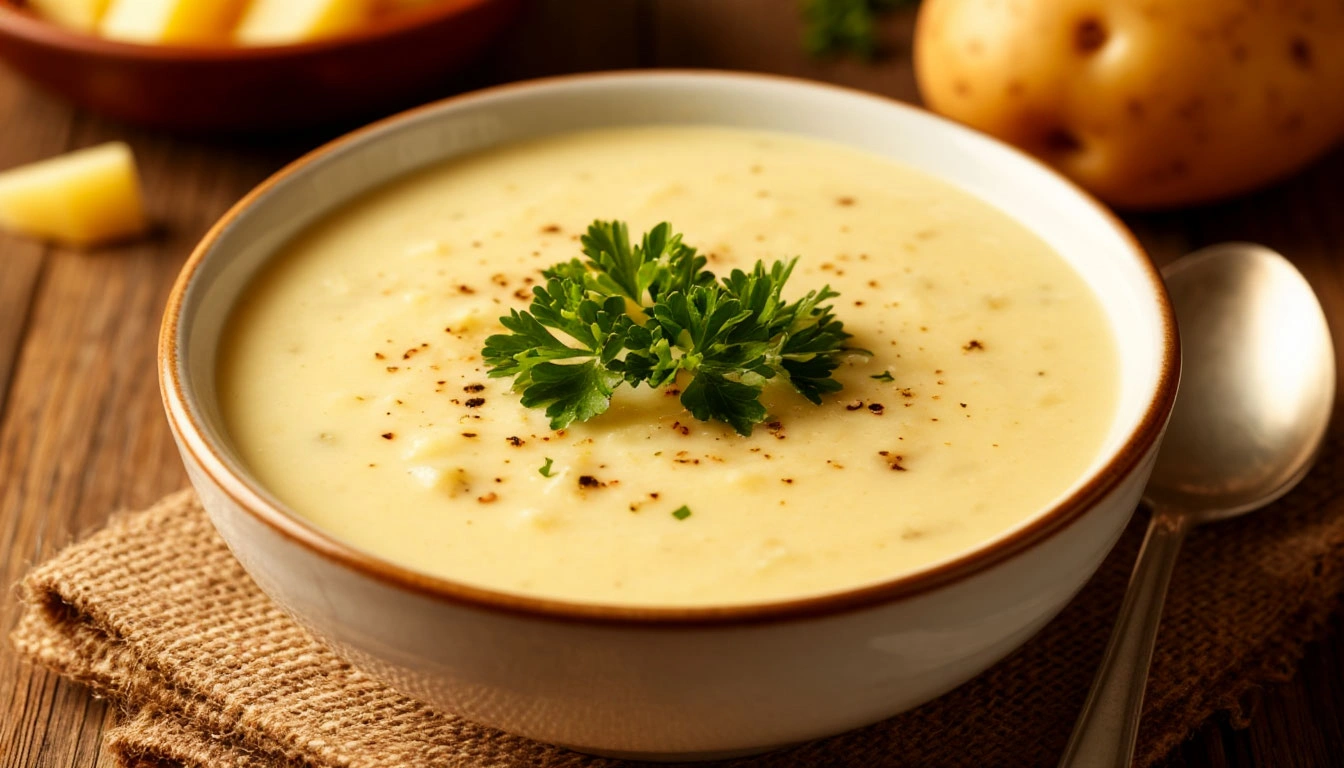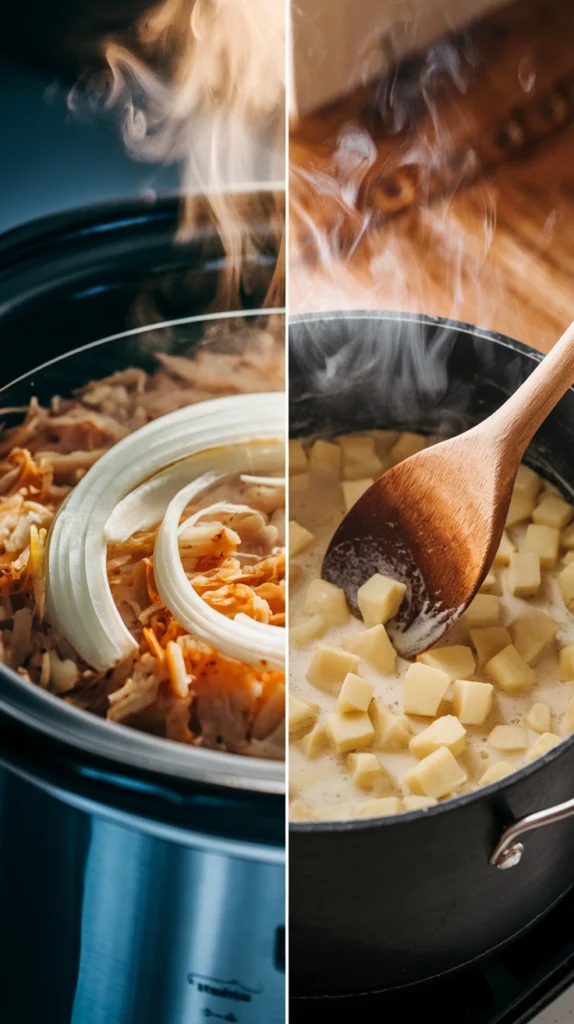The Best Healthy recipes & Workout you will fall in love with. Full of tips and tricks to help you make the best Version of You .

Table of Contents
Table of Contents
Creating the perfect creamy potato soup requires a combination of cooking techniques and flavor combinations. Whether you choose to simmer on the stovetop or use a slow cooker for convenience, each method adds its own special touch to this classic comfort dish.
Base Ingredients for Creamy Potato Soup
Creating the perfect creamy potato soup starts with selecting the right ingredients. Here’s your essential shopping list:
Core Ingredients:
- 2 pounds potatoes
- 1 medium onion
- 3 cloves garlic
- 4 cups broth
- 1 cup heavy cream
- Salt and pepper to taste
Potato Selection Guide
Yukon Gold potatoes shine as the top choice with their naturally buttery flavor and creamy texture. These golden beauties hold their shape while becoming tender, creating the perfect soup consistency. Russet potatoes serve as an alternative, offering a fluffier texture that breaks down easily for an ultra-smooth soup.
Broth Basics
Chicken broth adds rich, savory depth to your soup. For vegetarian options, vegetable broth works beautifully, bringing its own unique blend of flavors from carrots, celery, and herbs.
Cream Components
Heavy cream creates that signature silky texture, but several alternatives exist:
- Sour cream: Adds tanginess
- Greek yogurt: Lighter option with protein boost
- Cream cheese: Creates extra thickness
- Half-and-half: Reduces calories while maintaining creaminess
Cooking Methods

Slow Cooker Method
The slow cooker method transforms frozen hash browns into a velvety potato soup with minimal effort. Here’s how:
- Layer frozen hash browns in your slow cooker
- Add diced onions and minced garlic
- Pour broth to cover the potatoes
- Cook on low for 6-8 hours or high for 3-4 hours
- Stir in cream during the last 30 minutes
Stovetop Mastery
Creating potato soup on the stovetop offers quick results and deep flavor development:
- Sauté Base Aromatics: Heat butter in a large pot, cook diced onions until translucent (5-7 minutes), add minced garlic for 1 minute
- Build the Soup: Add diced potatoes and broth, simmer until potatoes are tender (15-20 minutes), remove 2 cups of the mixture, blend until smooth, return to pot for ideal texture
- Achieve Perfect Consistency: Blend 1/3 of remaining potatoes for extra creaminess, keep some chunks for texture, stir occasionally to prevent sticking
Pro Tip: For the stovetop method, cutting potatoes into uniform sizes ensures even cooking and prevents mushy spots.
Flavor Enhancements and Variations on Creamy Potato Soup
Transform your basic potato soup into a gourmet experience with these creative additions and variations:

Classic Toppings
- Crispy bacon crumbles
- Sharp cheddar cheese
- Fresh chives or green onions
- Sour cream swirl
- Homemade croutons
Spice Blends
- Ancho chili powder for smoky heat
- Smoked paprika
- Fresh cracked black pepper
- Red pepper flakes
- Italian herb blend
Protein-Rich Variations
- Diced ham chunks
- Grilled chicken strips
- Crispy pancetta
- Smoked turkey
Vegetable Boost
- Steamed broccoli florets
- Sautéed mushrooms
- Roasted corn kernels
- Caramelized leeks
- Baby spinach leaves
Each vegetable addition brings unique nutritional benefits:
- Broccoli: Vitamin C and fiber
- Mushrooms: Vitamin D and B vitamins
- Spinach: Iron and antioxidants
- Leeks: Prebiotics and vitamin K
Regional Inspirations
- Irish Style: Mixed with cabbage and parsley
- German Twist: Added bratwurst and sauerkraut
- Southwest Kick: Green chilies and corn
- Mediterranean: Sun-dried tomatoes and herbs
These variations create distinct flavor profiles while maintaining the soup’s creamy texture. Mix and match ingredients to create your signature version of this classic comfort food.
Serving Suggestions and Storage Tips for Leftover Soup
Serve your creamy potato soup steaming hot at 165°F (74°C) for the perfect dining experience. A rustic bread bowl creates an impressive presentation, while a sprinkle of fresh chives and a swirl of cream adds elegant finishing touches.
Perfect Pairings:
- Grilled cheese sandwiches on sourdough
- Caesar salad with homemade croutons
- Crusty garlic bread
- Light mixed green salad with vinaigrette
Storage Guidelines:
- Let soup cool completely before refrigerating
- Store in airtight glass containers
- Keep refrigerated for up to 4 days
- Freeze flat in freezer bags for up to 3 months
Reheating Tips:
- Thaw frozen soup overnight in refrigerator
- Heat slowly over medium-low heat, stirring occasionally
- Add ¼ cup warm milk or broth per cup of soup to restore creamy texture
- Adjust seasoning after reheating
The soup naturally thickens during storage as starches continue to absorb liquid. Thin the consistency with warm liquid, adding small amounts until reaching desired texture. Avoid boiling reheated soup to prevent separation of dairy ingredients and maintain the smooth, creamy consistency.
Nutritional Information and Dietary Considerations
A standard serving (1 cup) of creamy potato soup contains:
- Calories: 180-220
- Carbohydrates: 25-30g
- Protein: 4-6g
- Fat: 8-12g
- Fiber: 2-3g
The nutritional profile varies based on ingredients and preparation methods. Using whole milk adds more calories and fat compared to reduced-fat alternatives. Heavy cream significantly increases the caloric content, while plant-based milk options can reduce it.
Key nutrients in potato soup include:
- Vitamin C from potatoes
- Calcium from dairy
- Potassium from potatoes and broth
- B vitamins from dairy products
For dietary modifications:
- Low-fat version: Use milk instead of cream
- Gluten-free: Skip flour thickener, use cornstarch
- Dairy-free: Substitute coconut milk or cashew cream
- Lower-carb: Replace some potato with cauliflower
The soup’s protein content increases with added bacon, ham, or cheese toppings. These additions also impact the total fat and sodium levels.
Enjoying Homemade Creamy Potato Soup as a Comforting Meal
Creating the perfect creamy potato soup is an art that combines simple ingredients with thoughtful techniques. Your kitchen becomes a place for culinary creativity – each batch offering opportunities to discover new flavor combinations and textures.
Start with our basic recipe, then let your imagination guide you. Add unexpected spices, try different potato varieties, or incorporate seasonal vegetables. The beauty of homemade potato soup lies in its ability to adapt to your taste preferences.
Ready to begin your soup-making journey? Remember:
- Trust your instincts
- Taste as you cook
- Adjust seasonings gradually
- Document successful variations
Your perfect bowl of creamy potato soup awaits – warm, comforting, and uniquely yours.
FAQs (Frequently Asked Questions)
What are the key ingredients for a classic creamy potato soup?
The essential ingredients for a classic creamy potato soup include Yukon Gold potatoes, chicken broth, heavy cream, and various seasonings. Yukon Gold potatoes are preferred for their buttery flavor and creamy texture.
What cooking methods can I use to make creamy potato soup?
You can prepare creamy potato soup using several methods: a slow cooker with frozen hash browns for convenience or on the stovetop for more control over flavor development. For stovetop preparation, sautéing onions and garlic enhances the soup’s flavor.
How can I enhance the flavors of my creamy potato soup?
To enhance the flavors of your creamy potato soup, consider adding toppings like crumbled bacon or shredded cheese. You can also incorporate spices such as ancho chili powder for an extra kick or add vegetables like broccoli for nutritional benefits.
What are some storage tips for leftover creamy potato soup?
For proper storage, keep leftover creamy potato soup in airtight containers in the refrigerator. When reheating, if the soup has thickened, add a bit of broth or milk to restore its creamy consistency.
What is the nutritional information for creamy potato soup?
Typically, creamy potato soup contains around 200-300 calories per serving, depending on ingredients used. It’s important to note that it includes carbohydrates from potatoes and fats from heavy cream; consider alternative ingredients for lighter versions.
How can I serve creamy potato soup for maximum enjoyment?
Serve creamy potato soup hot, garnished with fresh herbs or crispy toppings. It pairs wonderfully with crusty bread or side salads to create a comforting meal experience.





